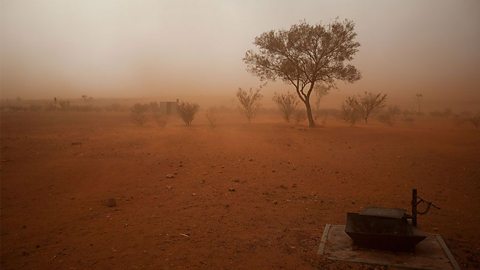Watch: Personification

Describing objects as if they are people is a way of making sentences more exciting.
This is called personification.
For example, Jess's heart is racing at 100 miles per hour. A heart can’t literally race, but it helps us to feel more involved in the story.
Try using personification in your own writing and speech.

What is personification?
Jeff: Janine, I'm reporting from the trackside as the stadium holds its breath in excitement.
Janine: I can almost picture it now…
Jeff: I can tell you that Jess' heart is racing at 100 miles per hour.
Janine: Outstanding personification, Jeff!
Jeff: Thanks Janine, I sometimes describe objects as if they're people, I find it makes my sentences more exciting.
Janine: It's as if we're there with you, Jeff.
Jeff: Oooh noooo!
Janine: What can you see, Jeff?
Jeff: That is one miserable shot put!
Janine: Ooh, that's more top drawer personification!
Jeff: Time for her final throw…
Oooh no, Janine, the score board is weeping in disappointment.
Janine: As am I, Jeff, as am I! Is there any good news for Jess?
Jeff: Not really, Janine…
Janine: Oh well, at least the camera loves her!
What is personification?

Personification makes sentences more exciting by:
- describing objects as if they are people
- describing objects as if they have feelings
For example:
The rain stomped angrily on the fragile roof like a grumpy giant.
The snow painted delicate white pictures on the ground as it fell gently from the sky.
In these examples, rain and snow are described as doing things that people would normally do - 'stomped angrily' and 'painted'.
Describing things in this way helps to bring settings to life.
When used as part of a setting description, examples of personification also help to set the mood of a scene.
In the first example above, we can imagine a very dark and angry mood, but in the second example the mood feels light and peaceful.

Activity 1
Activity 2
Can you complete this setting description activity, using personification as a technique in your writing?
1. Imagine you are watching someone film a dust storm in Australia.
2. Think about what the person could see while they were filming and how they might be feeling. You could use the photograph below as inspiration.

3. Write three sentences that use personification to describe:
- what the person filming could see
or
- how the person was feeling as they filmed
For example:
The dust swallowed everything in its path like a hungry monster.
Beads of nervous sweat swam down the woman’s forehead as she filmed.
Activity 3

Choose one of the five senses (hearing, sight, smell, taste or touch). Now write a sentence about the dust storm setting, using that sense and personification.
For example:
The taste of dust leapt around the man’s mouth as he braved the dust storm.

Play our English game to get ready for the SATs. gamePlay our English game to get ready for the SATs
In Crystal Explorers, use grammar, punctuation and spelling skills to explore jungles, caves and tombs on your mission!

More on Language
Find out more by working through a topic
- count6 of 9

- count7 of 9

- count9 of 9
